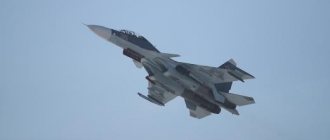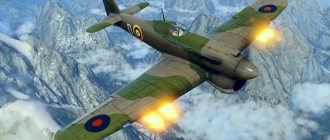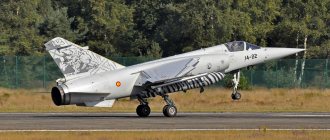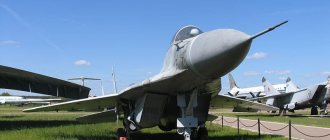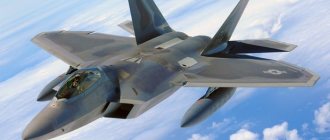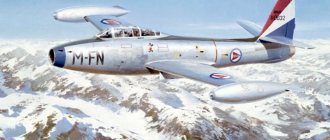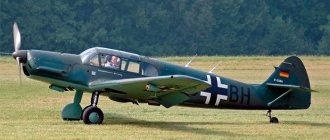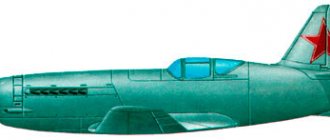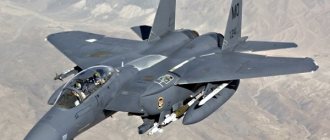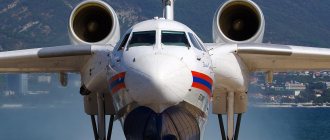Small but bold (F-5E multirole fighter)
After the end of World War II, the United States laid claim, and not without reason, to the role of world leader, in particular in aviation. The leadership obliged to provide economic and military-technical assistance to the allies.
The creation of jet aviation, which appeared at the final stage of World War II, required significant costs: while the development of the P-51 Mustang piston fighter required 154 thousand man-hours, the company spent 1.7 million man-hours on the subsonic jet F-86 Saber -hours. The implementation of its plans to create a supersonic fighter cost American taxpayers several times more than its predecessor
In a market economy, the Pentagon could choose the company executing the next program among the companies engaged in intense competition to receive a lucrative military contract. The feasibility study of the developers' proposals played an important role in this case.
In 1954, aircraft manufacturing experts, having analyzed the costs of creating and operating fighters of the “hundredth” series, which included the F-100, F-102, F-104, etc., came to the conclusion that they are directly dependent on the complexity of the aircraft and influence for their sales both in the domestic and foreign markets. According to Northrop experts, a light and simple machine with high flight-tactical characteristics could be a worthy competitor to the “hundredth” series fighters.
Preliminary studies of the N-102 Fang, a lightweight single-engine fighter with a delta wing and ventral air intake, were carried out by the company in the early 1950s. The design ideas of this machine were further developed in the Northrop project N-156 or SS-420A, proposed by the company to the American Navy for use from escort aircraft carriers. At the same time, the company offered this light twin-engine supersonic aircraft for delivery to US allies under the state military-technical assistance program (Military Assistance Program - MAP).
In the fall of 1955, the designers focused their efforts on developing the N-156T trainer aircraft in order to submit materials for consideration by the Air Force competition commission on supersonic training aircraft in March of the following year. In the summer of 1956, the N-156T was recognized as the winner of the competition, and in December it received an official an order for the production of three prototypes of the control system within the framework of the SS-420L program. In June 1958, to speed up the program, the Air Force increased the number of prototype aircraft to seven.
On April 10, 1959, the first prototype of the training facility took off, designated T-38. A year later, serial production of the T-38A with two J85-GE-5 turbojet engines with a thrust of 1215 or 1750 kgf in afterburning mode A took off. On March 17, 1961, the official transfer of the first aircraft took place. at the disposal of the Air Force Training Command. The Air Force initially ordered 744 vehicles, but by the time production ended in January 1972, the number was 1,187. The training device was manufactured in two versions: T-38A - for initial training and T-38B - for an increased level of training. The T-38B differed from the T-38A in the expanded composition of flight navigation equipment, mainly in the front cockpit, here an angle indicator was additionally located above the instrument panel attacks and an optical sight with a photo machine gun. The T-38 aircraft had high reliability: according to statistics, there are 2.2 flight accidents per 100 thousand flight hours. It is not for nothing that not only future American pilots are trained on them (their number has exceeded 40 thousand over the past time), but also NASA astronauts. In addition to the Americans, future pilots from Portugal, Taiwan and Turkey learned their profession there.
Work on the aircraft in the version of the light single-seat fighter N-156F until 1958 was carried out on its own initiative in parallel with the development of training equipment, which allowed the company, three months after the first flight of the T-38, to take off from the airfield in Palmdale (California) on July 30, 1959 F-5 fighter prototype. Following the completion of the first phase of testing in August 1960, three pre-production YF-5A (trade designation NF-5A) were tested under an extensive military test program as a multi-role fighter, assessing their suitability for operation in a variety of climates from the tropics to the Arctic, day and night. YF-5A - the first of the American supersonic jet fighters to take off and land on a dirt airfield.
After the successful completion of military tests in April 1962, the US Department of Defense allocated $20 million to the company under the MAP program. In October 1963, the first production F-5A was produced in the fighter-bomber version. Production aircraft were produced with more powerful J-85-GE-13 engines than the T-38 with an afterburner thrust of 1780 kgf.
At the same time, under the MAP program, the company developed the F-5B two-seat tactical combat training fighter, which took off on February 24, 1964. The Iranian Air Force was the first of the US allies to receive new fighters in January 1965. In the same year, F-5A and F-5B were delivered to the air forces of Greece, Taiwan, Turkey, the Philippines and the Republic of Korea. A modification of the F-5A fighter, developed for Norway, received the designation F-5G and differed from the base aircraft in the presence of a brake hook for landing on short runways and equipment designed for operation in Arctic conditions, a more powerful cabin heater, modified air intakes and the TACAN navigation system.
F-5A/B fighters could hit ground targets with conventional bombs, rockets and AGM-12B Bullpup guided missiles. To combat air targets, the aircraft was armed with two 20-mm M-39 automatic cannons with 280 rounds of ammunition each and two missiles "air-to-air" AIM-9 "Sidewinder". The maximum mass of the combat load placed on seven hardpoints was 2812 kg
Wanting to retain the niche it had won in the tactical fighter market, it modernized the F-5A/B aircraft already in 1965. The prototype, known as the F-5N or F-5A-15, was equipped with a more powerful and reliable J85-GE-15 engine with a thrust in afterburner mode of 1880 kgf and a radar located in the forward part of the fuselage instead of guns. Externally, production aircraft with this engine were distinguished by engine feed valves located on the air intakes, between the wing and stabilizer. At flight speeds of less than 530 km/h, mainly during takeoff and when performing turns at high altitudes, they provided additional air supply. The F-5A-15 also tested a new two-position nose landing gear. during the take-off run, it increased the angle of attack of the wing by 3 degrees, allowing the take-off run to be reduced by 25%.
To test the new fighter in combat conditions, the US Air Force conducted Operation Skoshi Tiger in 1965, forming the 4503rd Tactical Fighter Squadron (4503 TFS) from 15 F-5 fighters. Before being sent to Vietnam, the fighters were modified: overhead armor plates with a total weight of about 100 kg were placed on the bottom of the fuselage, and a fuel receiving device for in-flight refueling was installed in front of the cabin. A new attitude indicator was installed on the instrument panel. After modifications, the aircraft received the designation F-5C (the designation F-5TFS is also found). The fighters of the 4503rd Squadron, led by the KC-135 tanker aircraft, crossed the Pacific Ocean under their own power and landed at Bien Hoa Air Base on October 10, 1965
Within five hours after landing, the aircraft made their first combat mission. During the four months spent in Vietnam, the squadron completed about 3,500 sorties with a total duration of 4,000 hours. The aircraft carried out various combat missions over the territories of South and North Vietnam. When bombing ground targets, a typical combat load did not exceed 1360 kg (four Mk 117 bombs weighing 340 kg each) The maximum distance to the target was 330 km. During the operation, one fighter received combat damage: on December 16, 1965, one of the turbojet engines was disabled by small arms fire, but the pilot managed return to your airfield on a working turbojet engine and land the car. According to American experts, the aircraft turned out to be quite effective, although not without its drawbacks - a short combat radius and a long takeoff run in the overload version (up to 2 km). The 4503rd Tactical Fighter Squadron was returned to the United States, and the South Vietnamese Air Force delivered about 120 F-5 fighters until the end of the war, of which over 50 were F-5E modifications
To expand the sales market, in 1965 the company offered a reconnaissance version of the F-5 Tiger (the name Freedom Fighter, which originally adorned the noses of prototypes and pre-production vehicles, gradually went out of circulation). Three, and later four, 70 mm cameras with interchangeable lenses were placed in the modified forward fuselage of the RF-5A. At the same time, the aircraft retained its cannon armament. The first serial reconnaissance aircraft were produced in 1965. In total, 107 copies were built before 1972.
Given the special relationship between the United States and Canada, the F-5A/B for the Royal Canadian Air Force was built under license with J85-Can-15 engines produced in Malton. Canadian aircraft received the traditional designations CF-5A and CF-5D in such cases. To increase the capabilities of the aircraft, the Canadians modified it for in-flight refueling, installed a fuel receiver on the right side of the fuselage, strengthened the glass of the canopy, equipped the aircraft with a brake hook, a two-position nose strut and turbojet replenishment windows as on the F-5N. On the reconnaissance version, Vinten cameras were used, photography was carried out through three or seven windows. The flight and navigation equipment and weapon control system were modernized. On the Canadian spark, guns were removed and an optical generator was installed to illuminate the target when using weapons with a laser guidance system.
In February 1968, the word Royal disappeared from the name of the Canadian Air Force, and the modernized Canadair aircraft received new designations. The single CF-5A became known as the CL-119, and the double CF-116
The first production CL-119 took off in May 1968, followed by the CF-116 four months later. A total of 89 single-seat and 46 two-seat fighters were built for the Canadian Air Force. Some of them were subsequently sold to Venezuela
In the development of jet aviation in the second half of the 20th century, broad cooperation became characteristic, without which not only economically viable development, but also the production of aircraft is impossible. Such a popular aircraft as the F-5 is no exception. The Dutch, in cooperation with Canadair, organized in 1969 year, production of the most advanced version of the F-5A/B modification. New avionics, including a Ferranti laser rangefinder, were installed on 75 single-seat NF-5A and 30 double-seat NF-5B aircraft intended for the Dutch Air Force and equipped with Canadian engines. A device for shooting dipole reflectors and false targets “Tractor Aerospey” was installed on the rear part of the fuselage. The aircraft could be refueled in flight. After strengthening the wing structure, it was possible to hang 275-gallon outboard fuel tanks on it. In addition, the wing mechanization was improved: deflectable tips, flaps and their electric drive, which made it possible to significantly improve the flight performance of the aircraft when maneuvering
The Spanish aviation company CASA organized the production of the F-5A/B with the technical support of the Americans. The first licensed aircraft, which received the brand designations SF-5A, SF-5B and SRF-5A and, accordingly, the Spanish C-9, CE-9 and CR-9, are fully assembled from American components, later only engines were supplied from the USA. In total, 18 C-9, 36 SE-9 and 18 CR-9 were built in Spain.
The wars in Vietnam and the Middle East contributed to the revision of existing views on the combat use of tactical fighters. These trends were taken into account not only in newly developed machines, they tried to quickly implement them on mass-produced fighters. Many technical solutions used on various versions of the F-5A / B were tried to concentrate in a new basic modification, focused primarily on maneuverable air combat in simple weather conditions. By this time, she had created another modification of the J85-GE-21 engine with an afterburner thrust of 2185 kgf. On the new modification, designated F-5E "Tiger II"
— used a lift control system depending on the flight mode, as on the Dutch NF-5A/B; —increased the wing area by changing the span and shape of the sagging in its front part; — equipped the aircraft with a brake hook, tested on the Canadian, Norwegian and Dutch versions; —installed pulse radar AN/APQ-153; - guided weapons were supplemented with modern AGM-65 Maevrick air-to-surface missiles, Mk. 84 LGB with a laser guidance system - significantly changed the flight navigation equipment and weapon control system; —the fuel supply in the internal tanks was increased by 300 liters due to the lengthening and expansion of the fuselage; - the entrance area of the air intakes and engine supply channels began to correspond to the increased air consumption of the turbojet engine; - the base and track of the chassis were increased, equipping it with a two-position nose strut.
The weight of the F-5E fighter compared to the original aircraft has increased by one ton at normal take-off weight and by almost two ton in the overload version.
The aircraft, which became heavier and, accordingly, more expensive, nevertheless did not lose its attractiveness for potential buyers. As a result of modernization, the maximum combat load, speed, rate of climb and angular rate of turn increased, the turning radius and take-off distance decreased.
The first production F-5E took to the skies on August 11, 1972, its two-seat modification F-5F - four years later. The combat training F-5F, unlike previous twins, has built-in cannon armament: an M-39A3 air cannon with 140 rounds of ammunition is located in the forward part of the fuselage on the left.
Aircraft of the F-5E/F modification were built serially until 1988: a total of 1,162 single-seat aircraft and 242 combat trainers were produced, including fighters assembled in Switzerland, as well as those built under license by KA from the Republic of Korea and Taiwanese AIDC In addition to the above-mentioned aircraft of this modification There is the RF-5E Tigerai tactical reconnaissance aircraft, developed in 1979 and built in 12 copies.
F-5E/F fighters were part of the air forces of Bahrain, Brazil, Honduras, Indonesia, Jordan, Iran, Kenya, Malaysia, Morocco, Mexico, the Republic of Korea, Saudi Arabia, North Yemen, Singapore, Sudan, Thailand, Tunisia, and the Philippines. One hundred and fifty F-5E/F fighters took an active part in the Iran-Iraq war of 1980-1988, thanks to their simplicity and high reliability, they participated in combat operations throughout the war, while other American-made Iranian aircraft stood idle due to lack of spare parts Moroccan F-5A and F-5E took part in battles in Western Sahara.
On August 30, 1983, another modification of the F-5G fighter (later called F-20) took off from the airfield in a single-engine version with a modern on-board radio-electronic complex. The aircraft was equipped with an F-404-GE-100 engine with an afterburning thrust of 8000 kgf. Despite a significant improvement in flight performance, the aircraft did not arouse the expected interest
In the future, to extend the service life of the F-5 family, it focused its efforts on modernization, proposing to equip it with a modern radio-electronic complex. It was planned to equip the aircraft with an improved APG-66 radar, an on-board digital computer, a heads-up display and multifunction displays, an inertial laser system on laser gyroscopes . The F-5E fighter, modernized by an alliance formed by Northrop-Grumman, Bristol, Samsung, CRDA and CASA, under the Tiger IV program, was tested for three months in 1995 at Edwards Air Force Base, and in October it was successfully performed demonstration flights at Kelly Air Force Base.
There are other aircraft improvement programs. in the early 1990s, the Spanish CE-9s were modernized by replacing the wing, friend-foe identification equipment, and installing radar warning equipment. At the end of the 20th century, the national company EMBRAER and the Israeli Elbit Systems installed modern electronic equipment on Brazilian Tigers. Elbit Systems also took part in the modernization of Turkish and Singaporean F-5s. The Air Forces of Canada, Indonesia and Chile have modernized their fighters. The US Air Force expects to use the modernized T-38 until 2010
The F-5E also left its mark in the Soviet sky. After the end of the Vietnam War in the USSR, among other aircraft, the Tiger II, serial number 73-00807, was delivered to the Chkalovsky airfield near Moscow. After studying the aircraft by specialists from the Air Force Research Institute, the leadership of the Air Force and the Ministry got acquainted with it aviation industry. The leading engineer from the research institute for the study of the F-5E was V. Evteev. After studying, the aircraft was prepared for flight. The chief engineer of the Air Force Research Institute, Yakovlev, had a lot of trouble making the stabilizer ball bearing, which was destroyed during the preparation of the fighter for transportation from the Democratic Republic of Vietnam. On the initiative of the head of the Air Force Research Institute, General I.D. Gaidaenko, supported by the Deputy Commander-in-Chief of the Air Force for Armament M.N. Mi-shuk, comparative tests and training battles were carried out with domestic MiG-21bis and MiG-23ML fighters. Test pilots of the Air Force Research Institute N.I. Stogov, V.N. Konda-urov, A.S. Bezhevets and Air Force inspector Uryadov took part in this work. The technical staff who prepared the elegant American aircraft for flight remembered it for its simplicity and thoughtfulness of design, ease of access to the serviced units. One of the participants in the study of the American aircraft, leading engineer of the Air Force Research Institute A. I. Marchenko, remembering, noted such an advantage of the fighter as a glare-free instrument panel: high-quality coated instrument glass in any lighting did not create problems with reading information. Air Force Research Institute engineers puzzled over the purpose of the button at the bottom of a deep niche in the cockpit for a long time. As it turned out later, it was intended to remove the lock on the use of weapons with the landing gear extended
The pilots appreciated the comfort of the cabin, good visibility from it, rational placement of instruments and controls, easy takeoff and excellent maneuverability at high subsonic speeds. The F-5E flew in Vladimirovka for about a year until one of the landing gear tires collapsed. After testing at the Air Force Research Institute, the aircraft was transferred to TsAGI for static tests, and many of its components and assemblies ended up in aircraft industry design bureaus, where interesting technical solutions were used in the development of domestic aircraft. In addition to Soviet specialists, Polish engineers became acquainted with the American fighter; in 1977, they received from Vietnam an aircraft with serial number 73-00852, intended to evaluate the possibility of rearmament with Soviet NR-23 cannons. This proposal was not implemented. The third F-5E, serial number 73-00878, was brought in two crates from a Czechoslovakian L-39 Albatross trainer to the Prague Air and Space Museum in 1981, where it remains to this day.
F-5E multi-role fighter:
1 — AN/APG-159 radar radome; 2 — antenna of the TACAN navigation system; 3—20-mm M-39A2 air cannon; 4 — combined antenna of the state identification system and microwave; 5 — cannon armament compartment cover; 6 — flap of the front landing gear compartment; 7 — canopy visor; 8 — ejection seat HRQ7A; 9— movable part of the lantern; 10 — perforation of the air intake wedge, 11 — VHF radio antenna; 12 — turbojet recharge valves; 13 — antennas of the TACAN system; 14 — radio transponder antennas; 15 — tail aeronautical light; 16 — rudder, 17 — brake parachute container, 18 — brake hook; 19 — shield of the main landing gear, 20 — built-in ladder, 21 — two-position front landing gear; 22 — wheel 430×160 mm; 23 — main wheel BOOх 176 mm, 24 — strut; 25 — hydraulic cylinder for retracting (releasing) the landing gear; 26 — brake flap; 27 — niche door of the main landing gear; 28 — shock-absorbing strut; 29 — wing influx, 30 — deflectable toe; 31 — missile launcher, 32 — air-to-air missile AIM-9J Sidewinder; 33 — technological hatch; 34 — aileron; 35—flap; 36—all-moving stabilizer; 37 — outer wing pylon, 38 — LAU-3/A block for 70 mm NAR, 39 — PV rod; 40 - 275-gallon external fuel tank, 41 - ventral pylon, 42 - Mk. 84LGB; 43 — inner wing pylon; 44 - aerial bomb Mk. 82GP "Snekay"; 45 — rocket launcher; 46 - AGM-65 air-to-surface missile, 47 - Mk. 83; 48 — suspended gun container SUU-16/A; 49 — nozzle TRD J85-GE-21; 50 — operational hatch of the turbojet engine; 51 — turbojet engine control levers; 52 — optical sight reflector, 53 — magnetic compass, 54 — rearview mirror; 55 — aircraft control stick; 56 — pilot's seat; 57 — network circuit breaker panel; 58 — SKYSPOT system antenna; 59 — radio equipment compartment; 60 — engine compartment cooling air intake, 61 — turbojet engine F404-GE-100
| Modification name | T-38 | F-5A | F-5E | F-20 |
| Empty aircraft weight, kg | 3479 | 3670 | 4392 | 5965 |
| Take-off weight, kg | — | 6080 | 7030 | — |
| Maximum take-off weight, kg | 5485 | 9380 | 11 200 | 12 700 |
| Mass of fuel in internal tanks, kg | 1665 | 1573 | 2000 | — |
| Maximum combat load weight, kg | — | 2812 | 3175 | — |
| Aircraft length, m | 14,13 | 14,4 | 14,68 | 14,4 |
| Wingspan, m | 7,7 | 7,7 | 8,13 | 8,13 |
| Wing area, m2 | 15,79 | 15,79 | 17,3 | 18,6 |
| Aircraft height, m | 3,92 | 4,06 | 4,06 | 4,22 |
| Maximum speed, km/h: | ||||
| near the ground | — | 1306 | 1223 | 1487 |
| at high altitude | 1270 | 1740 | — | 2090 |
| Practical ceiling, m | 16 335 | 15 390 | 16 460 | 17315 |
| Ferry range, km | 1815 | 2594 | 2860 | 3734 |
N.SEKACH “Model designer” No. 3'2007
Work on the specifications issued by the Pentagon in 1958 was carried out on the basis of the N-156 , but behind it stood an earlier development under the designation N-102 “Fang” . During this period, the Americans “looked back” at the British light fighter Folland “Gnat”, which was developed with a two-year design by Northrop - the main problem was the lack of compact jet engines capable of providing supersonic speed. Only the advent of the General Electric J85 engine made it possible to finally decide on the concept of an ultra-light fighter, but further development of the N-102 had to be abandoned in favor of the more promising N-156.
The design of the new aircraft has been carried out since 1955 in two directions at once. The N-156T was a two-seat fighter trainer intended to replace the Lockheed T-33, while the N-156F was a single-seat light fighter armed with only two missiles. In November 1955, after a number of discussions, it was decided to focus on the training modification and already in June 1956, the USAF signed a contract to build three experimental YT-38s . Testing of these aircraft was successful and in 1961 they were put into service under the designation T-38 “Talon” . The story with the combat modification was somewhat different.
Due to the higher priority of work on the N-156T, the design of the N-156F (already dubbed the “Freedom Fighter” ) slowed down, but they resumed as before in 1958. The first prototype was built in May 1959, and two months later its flight tests began, and the sound barrier was broken on the very first flight.It would seem that events were developing successfully, but in August the USAF abandoned the ultra-light fighter, which managed to receive the designation F-5 . The reasons for this step were not only opportunistic - in fact, the United States was to some extent oversaturated with combat aircraft for a variety of purposes and the serial construction of another fighter, albeit a successful one, was not profitable from an economic point of view.
Perhaps the F-5 would have remained at the prototype level, but the rise to power of John Kennedy, who promoted the initiative of a comprehensive “fight against communism,” one of the foundations of which was the expanded supply of military equipment, helped. The inexpensive Northrop aircraft fit very well into the new framework, and in April 1962 it was announced that fighters of a new modification would be supplied for export to friendly countries, three prototypes of which were designated YF-5A .
To save on costs, only one “full-fledged” prototype was produced in 1963, after which the first two F-5s were brought to its standard. The third of them was finalized according to a modernized design - two more suspension units were added under the wing, bringing them to four, and two 20-mm Colt-Browning M39 cannons were installed in the forward fuselage. After a number of subsequent minor modifications, the fighter received the designation F-5A and entered mass production. Subsequently, this aircraft served as the basis for a whole series of modifications, among which were not only “pure” fighters.
N-156F
- single-seat fighter, 1 prototype built.
XF-5A
- single-seat fighter, 1 prototype built for static testing.
YF-5A
- single-seat fighter, 3 prototypes built.
F-5A
- single-seat fighter with AN/APQ-15 radar, production version.
F-5A(G)
- a single-seat fighter based on the F-5A for the Norwegian Air Force.
F-5C “Skoshi Tiger”
— a single-seat fighter based on the F-5A with a refueling boom and armored fuel tanks, 12 aircraft have been modified.
F-5E “Tiger II”
- single-seat fighter based on the F-5A with AN/APQ-159 radar, production version.
F-5E “Tiger III”
- a single-seat fighter with an EL/M-2032 radar and the ability to carry Python missiles for the Chilean Air Force.
F-5E/F
- single-seat fighter for the Swiss Air Force.
F-5G
- single-seat fighter based on the F-5E, temporary designation for the F-20 “Tigershark”.
F-5N
- single-seat fighters based on the F-5E transferred by Switzerland to the USAF.
F-5S
- a single-seat modernized fighter for the Singapore Air Force, version with AIM-120 AMRAAM missiles.
F-5T “Tigris”
- a single-seat modernized fighter for the Thai Air Force.
F-5TF “Tigris”
— a two-seat version of the F-5T fighter.
F-5EM
- a single-seat modernized fighter for the Brazilian Air Force with the Italian Grifo-F radar.
F-5TIII
- a single-seat modernized fighter for the Moroccan Air Force.
F-5E “Tiger 2000”
- a single-seat modernized fighter for the Taiwan Air Force.
RF-5A
— single-seat reconnaissance version based on the F-5A.
RF-5A(G)
- single-seat reconnaissance version based on the F-5A for the Norwegian Air Force.
RF-5E “Tigereye”
— — single-seat reconnaissance version based on the F-5E for the Malaysian and Saudi Arabian Air Forces.
RF-5E “Tigergazer”
— — single-seat reconnaissance version based on the F-5E for the Taiwanese Air Force, modernized by ST Aerospace.
RF-5S “Tigereye”
- single-seat reconnaissance version based on the F-5S for the Singapore Air Force.[16]
The operational career of the F-5 aircraft turned out to be very eventful with various events. The first contract was completed for Iraq (which was then an ally of the United States), after which the “Fighters” began to spread widely around the world. Suffice it to say that in addition to countries such as Canada and Spain, where these aircraft were produced under license, the F-5 entered service with such countries as Bahrain, Botswana, Brazil, Venezuela, the Netherlands, Honduras, Indonesia, Jordan, Iraq, Yemen, Kenya, Libya, Malaysia, Mexico, Morocco, Norway, Saudi Arabia, Singapore, Sudan, Thailand, Tunisia, Taiwan, Turkey, Philippines, Switzerland, Ethiopia, South Korea and South Vietnam.
This more than decent list was supplemented by the Socialist Republic of Vietnam in 1972, but in this case the F-5s were not received from the Americans, but became trophies after the end of the civil war. Meanwhile, aircraft of a separate modification, the F-5C, belonged to the 4503 TFS USAF and were flown by American pilots. A total of 20 of these vehicles were produced and were used in Vietnam since October 1965.
Aircraft from the Ethiopian Air Force also took part in the fighting. During the war with Somalia over the Ogaden province in 1977, Ethiopian F-5As were flown by pilots from Israel, with which military cooperation was then maintained.
Moroccan, Saudi, Pakistani and Iranian F-5As also fought - the latter were especially widely used in the 1979-1988 war. with Iraq. By the way, the Iranians have launched the production of their own modifications under the names “Azarakhsh”
,
“Sa'eqeh”
and
“Kowsar”
.
The general opinion about this aircraft is more than good, and in a number of countries the “Freedom Fighters” are still in use to this day.
Northrop N-156F - prototype single-seat fighter, 1959
